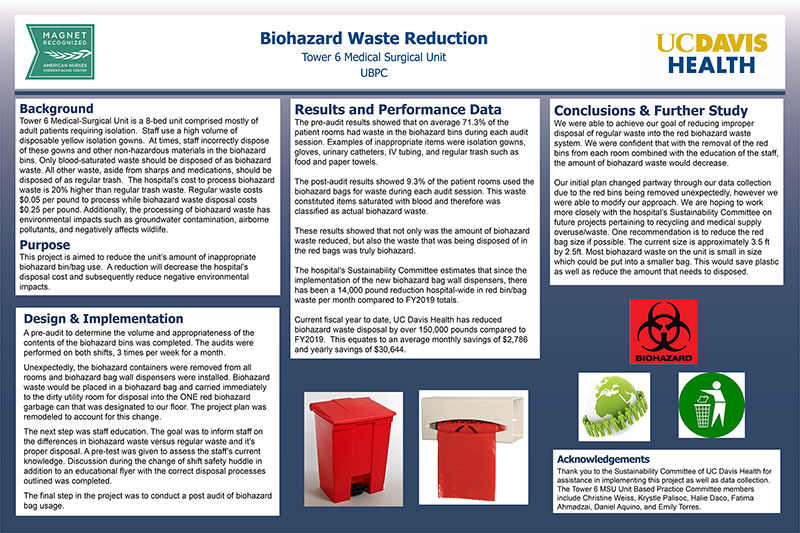
Hover to pan and click to magnify. Click again to pan at full screen.
Christine Weiss, CNIII, RN, Krystle Palisoc, CNIII, RN, Halie Daco, CNII, RN, Fatima Ahmadzai, AN2, RN, Emily Torres, Nurse Manager
Christine Weiss, CNIII, RN, Krystle Palisoc, CNIII, RN, Halie Daco, CNII, RN, Fatima Ahmadzai, AN2, RN, Emily Torres, Nurse Manager
UC DAVIS HEALTH -QUALITY IMPROVEMENT
Background
Tower 6 Medical-Surgical Unit is a 8-bed unit comprised mostly of adult patients requiring isolation. Staff use a high volume of disposable yellow isolation gowns. At times, staff incorrectly dispose of these gowns and other non-hazardous materials in the biohazard bins. Only blood-saturated waste should be disposed of as biohazard waste. All other waste, aside from sharps and medications, should be disposed of as regular trash. The hospital’s cost to process biohazard waste is 20% higher than regular trash waste. Regular waste costs
$0.05 per pound to process while biohazard waste disposal costs
$0.25 per pound. Additionally, the processing of biohazard waste has environmental impacts such as groundwater contamination, airborne pollutants, and negatively affects wildlife.
Purpose
This project is aimed to reduce the unit’s amount of inappropriate biohazard bin/bag use. A reduction will decrease the hospital’s disposal cost and subsequently reduce negative environmental impacts.
Design & Implementation
A pre-audit to determine the volume and appropriateness of the contents of the biohazard bins was completed. The audits were performed on both shifts, 3 times per week for a month.
Unexpectedly, the biohazard containers were removed from all rooms and biohazard bag wall dispensers were installed. Biohazard waste would be placed in a biohazard bag and carried immediately to the dirty utility room for disposal into the ONE red biohazard garbage can that was designated to our floor. The project plan was remodeled to account for this change.
The next step was staff education. The goal was to inform staff on the differences in biohazard waste versus regular waste and it’s proper disposal. A pre-test was given to assess the staff’s current knowledge. Discussion during the change of shift safety huddle in addition to an educational flyer with the correct disposal processes outlined was completed.
The final step in the project was to conduct a post audit of biohazard bag usage.
Results and Performance Data
The pre-audit results showed that on average 71.3% of the patient rooms had waste in the biohazard bins during each audit session. Examples of inappropriate items were isolation gowns, gloves, urinary catheters, IV tubing, and regular trash such as food and paper towels.
The post-audit results showed 9.3% of the patient rooms used the biohazard bags for waste during each audit session. This waste constituted items saturated with blood and therefore was classified as actual biohazard waste.
These results showed that not only was the amount of biohazard waste reduced, but also the waste that was being disposed of in the red bags was truly biohazard.
The hospital’s Sustainability Committee estimates that since the implementation of the new biohazard bag wall dispensers, there has been a 14,000 pound reduction hospital-wide in red bin/bag waste per month compared to FY2019 totals.
Current fiscal year to date, UC Davis Health has reduced biohazard waste disposal by over 150,000 pounds compared to FY2019. This equates to an average monthly savings of $2,786 and yearly savings of $30,644.
Conclusions & Further Study
We were able to achieve our goal of reducing improper disposal of regular waste into the red biohazard waste system. We were confident that with the removal of the red bins from each room combined with the education of the staff, the amount of biohazard waste would decrease.
Our initial plan changed partway through our data collection due to the red bins being removed unexpectedly, however we were able to modify our approach. We are hoping to work more closely with the hospital’s Sustainability Committee on future projects pertaining to recycling and medical supply overuse/waste. One recommendation is to reduce the red bag size if possible. The current size is approximately 3.5 ft by 2.5ft. Most biohazard waste on the unit is small in size which could be put into a smaller bag. This would save plastic as well as reduce the amount that needs to disposed.
Acknowledgements
Thank you to the Sustainability Committee of UC Davis Health for assistance in implementing this project as well as data collection. The Tower 6 MSU Unit Based Practice Committee members include Christine Weiss, Krystle Palisoc, Halie Daco, Fatima Ahmadzai, Daniel Aquino, and Emily Torres.

Present with Google Meet
Invite as many as 30 people, and present your poster in high definition. Transcription option is available. Free to use.
DISQUS COMMENTS WILL BE SHOWN ONLY WHEN YOUR SITE IS ONLINE